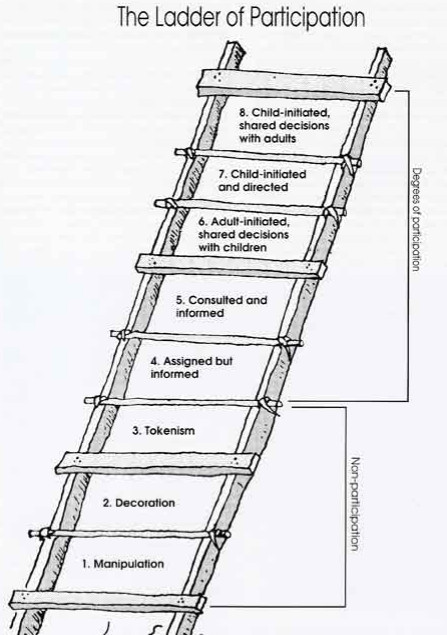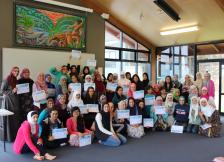
The Webster Dictionary defines the word “engage” as attracting and holding by influence or power, to hold the attention of, and to induce to participate. Engagement is defined as the act of engaging.
“Youth engagement means planting the seed of Islam in the hearts of our kids. Through consistent nurturing and education, youth develop a strong Muslim identity, which fully blossoms when they reach adulthood” -Shadi Jabali, youth leader.
Youth would define youth engagement as:
-
Being respected and trusted
-
To be a part of something, and directly involved in it
-
Empowerment
-
Power to make a change, to do something
-
Teamwork
Youth engagement is essentially making the youth part and parcel of the fabric of the community in a meaningful way. It is to have them not only be included in programs, but to be leading as well. It is to build up their confidence, self-esteem, and self-motivation. It means to treat them as young adults who are capable of making moral, intellectual, and even spiritual decisions. Youth engagement is not to remove the adults from the picture, but to have the adults tap into their own mentorship wisdom and apply it in ways that will empower the youth and make our community stronger, moving from adult-as-mentor to adult-as-partner.
Why Youth Engagement?
Prophet Muhammad, peace and blessings be upon him, told us that those who invest with their wealth, with their knowledge, and in their children will continue to receive reward for that investment even long after their death. He encouraged us to plant a seed of goodness even in the most desperate of times and to trust that Allah will never leave a good intention unrewarded. In these difficult times, when the faith of our children is challenged and when holding on to faith is like holding onto a hot coal, engaging with our youth is, now more than ever, an honorable way to live the immaculate Prophetic example, and to be, as he was, a mercy to mankind and beacon of light for all creation.
Benefits of Youth Engagement
According to the paper series An Emerging Model for Working with Youth Community Organizing + Youth Development = Youth Organizing, there are numerous benefits to youth engagement. These include:
- Positive identity
- Increased knowledge and skills
- Deeper commitment to community
- Cultural Competency - it gives youth a stronger self-esteem, cultural awareness, and self-reflection. It also builds youth confidence by helping them identify what they can do to positively impact the world.
- Personal Competency - being able to make personal decisions, solving one’s own problems, helping others solve problems, as well as being thoughtful about their values, and how they apply them to their life conditions.
- Political Competency - an increased understanding of the values of institutions (like Masjids and schools) and confidence to effectively interact with and positively influence public and private institutions.
- Cognitive Competency - improvement in analytical, literacy, communication, strategizing and organizing skills, among others.
- Social Competency - increased understanding of teamwork in terms of conflict resolution, team-building, and respect for diversity. This allows young people to build stronger and better relationships with everyone in their lives.
Barriers to Youth Engagement
Based on a thinking retreat conducted by Muslim Youth Spirit (MYSpirit), a joint initiative of Sound Vision and DawaNet, and other research, the following are some barriers to youth engagement:
- Absence of Halal entertainment for youth
- Youth identity crisis
- Lack of youth & women’s representation in mosques
- Absence of tolerance within the Muslim community
- Generational and cultural gaps
- Lack of funding for non-Masjid projects/youth organizations
- Lack of mentors & role models
- Absence of professional counselling for youth
- Irrelevant and unwelcoming Khutbas, programs, and structures in Masjids and Islamic centers
- Lack of unity and networking among Muslims
- Parents being disengaged from the community
- Being treated like a child, without respect, being tokenized
- Lack of formal guidance to execute a project
- Youth being too busy
- Youth not knowing how to get involved
- Youth not being asked to get involved
“According to studies done in community psychology, one of the most intense barriers youth engagement can face is a lack of adult-youth leader interaction on the managerial level. Only through the combination of the wisdom of the previous generation and the on-the-ground knowledge of our more developed youth workers can effective youth engagement be achieved.” - Shadi Jabali
Youth Participation Ladder
This ladder from Roger Hart’s essay for UNICEF titled “Children’s Participation from Tokenism to Citizenship” shows the different levels youth may be engaged at. The lower three rungs are disempowering ways to engage the youth, and the upper rungs are the ideal place to be. The application of these rungs varies based on the situation of the community and the maturity of the youth involved. Moving up the ladder is also a gradual process.
For example: The Masjid board may hold a meeting and only have a youth present as a token, only to say “we have youth on our board”. That young person is not involved in any important decision-making. However, that young person can be on rung five, consulted and informed, when it comes to important decisions, or even rung six, adult-initiated with shared decisions, with the youth. For more details, please see Hart’s full report.
- Youth-initiated, shared decisions with adults: In this scenario, the youth are the main leaders and make major decisions, while the adults are involved in decision-making but are generally hands-off, and provide encouragement, as well as some advice.
- Youth-initiated and directed: The youth are the main leaders and direct. However, adults are still involved and participate in decision-making and events, or may act as supervisors.
- Adult-initiated, shared decisions with youth: Adults are the main leaders, but involve the youth with planning and decision making. Events are not specifically for the youth.
- Consulted and informed: Adults are the leaders, while they thoroughly consult youth and remain informed on the opinions of the youth, and take them seriously.
- Assigned but informed: The youth have a clear and thorough understanding of the project, and volunteer after understanding it, while having a meaningful role in the project.
- Tokenism: Although it may seem like the youth are being involved, they really are not given a real voice and are somewhat overlooked. Although the adults do believe the project is for the benefit of the youth, they do not involve them in a meaningful way.
- Decoration: This is when adults use children as a way to make it look like the youth are participating. The youth are, for example, asked to attend a meeting for a cause they don’t understand and are not informed about, for the sake of making it look like the youth are involved.
- Manipulation: This category may also be called “misguided adults.” This is when adults use children who do not understand what they are doing or promoting for a “greater cause.” Although it seems like the ends justify the means, it is manipulation. Example: preschool children wearing t-shirts with political statements.
Optimal Conditions for Youth Engagement
Youth will be engaged if some, most, or all of these conditions are met (survey report from the Centre of Excellence for Youth Engagement):
- The environment is youth-friendly
- They are involved in decision-making, and actually see progress or change, not just hear about it
- They are not being silenced, they are being heard
- They are not called “children”, but are treated with respect. Lines such as “grow up,” “you’re too young to understand,” and “it’s only a phase in life, you will outgrow it,” are all disempowering and condescending
- The environment created has a social aspect
- They have some level of authority or control
- Their creativity is welcome
Here are three reasons why youth engage, based on the Profile of Illinois: An Engaged State Illinois Civic Engagement Benchmark Survey Results:
- Altruism: They want to contribute to the world they live in in a positive and meaningful way. This is the top reason.
- Faith or fellowship: It can be that a youth is passionate about a social justice cause, Quran, playing basketball, or the arts, and if that program is in line with their motivation and beliefs, they will be happily engaged. Under this is also the positive influence from others. Friends joining something creates an instant connection. This is the second most important.
- Rational calculation or self-interest: Whether it is experience, socializing with friends, or even making some extra money, they will be engaged if there is a benefit to them.
Order Your Copy of
"Youth Engagement Manual for Masjids, MSA's and Community Leaders"










Comments
Add new comment